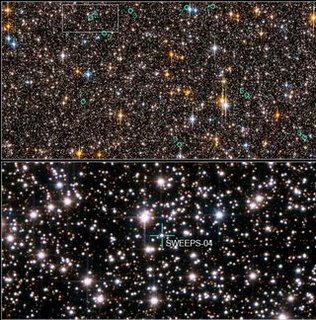 This is an image of one-half of the Hubble Space Telescope field of view in the Sagittarius Window Eclipsing Extrasolar Planet Search (SWEEPS). The field contains approximately 150,000 stars, down to 30th magnitude....The green circles identify 9 stars that are orbited by planets with periods of a few days. Planets so close to their stars with such short orbital periods are called "hot Jupiters." These are considered "candidate" exoplanets because most of them are too faint to allow for spectroscopic observations that would allow for a precise measure of the planet's mass.
This is an image of one-half of the Hubble Space Telescope field of view in the Sagittarius Window Eclipsing Extrasolar Planet Search (SWEEPS). The field contains approximately 150,000 stars, down to 30th magnitude....The green circles identify 9 stars that are orbited by planets with periods of a few days. Planets so close to their stars with such short orbital periods are called "hot Jupiters." These are considered "candidate" exoplanets because most of them are too faint to allow for spectroscopic observations that would allow for a precise measure of the planet's mass. From physorg.com.
The planet bonanza was uncovered during a Hubble survey, called the Sagittarius Window Eclipsing Extrasolar Planet Search (SWEEPS). Hubble looked farther than has ever successfully been searched for extrasolar planets. Hubble peered at 180,000 stars in the crowded central bulge of our galaxy 26,000 light-years away. That is one-quarter the diameter of the Milky Way's spiral disk. The results will appear in the Oct. 5 issue of the journal Nature.
Five of the newly discovered planets represent a new extreme type of planet not found in any nearby searches. Dubbed Ultra-Short-Period Planets (USPPs), these worlds whirl around their stars in less than one Earth day. ...
The planets are called "candidates" because astronomers could only obtain follow-up mass measurements for two of them due to the distance and faintness of these systems.... The planet candidate with the shortest orbital period, named SWEEPS-10, swings around its star in 10 hours. Located only 740,000 miles from its star, the planet is among the hottest ever detected. It has an estimated temperature of approximately 3,000 degrees Fahrenheit.
"This star-hugging planet must be at least 1.6 times the mass of Jupiter, otherwise the star's gravitational muscle would pull it apart," said SWEEPS team member Mario Livio. "The star's low temperature allows the planet to survive so nearto the star."
"Ultra-Short-Period Planets seem to occur preferentially around normal red dwarf stars that are smaller and cooler than our sun," Sahu explained. "The apparent absence of USPPs around sun-like stars in our local neighborhood indicates that they might have evaporated away when they migrated too close to a hotter star."
No comments:
Post a Comment